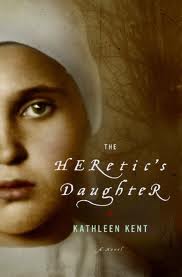The Heretic’s Daughter by Kathleen Kent
Reviewed by Karen

Ratings Explanation
Language: Some strong and crude language used.
Violence: There are descriptions of Indian raids and torturing 0f New Englanders. Also, there are descriptions of soldiers’ battles. Both are told in narrative form by those who were involved. Sarah’s father was a soldier in England participating in the death of King Charles I. Strife between families over land leads to fights and threats. Sarah is accosted by those begrudging her family. Martha is hung for being a witch.
Sexual Content: Sarah’s uncle is guilty of adultery. Mercy, a former indentured worker for the Carrier family, seduces Richard Carrier. She teaches Sarah how “all men are designed in like fashion.” After being turned out of the Carrier household on false pretensions of being pregnant, Mercy then becomes a “whore” in a local tavern. Menstruation mentioned.
Adult Themes: The book opens during the evil and dark hour in Salem, Massachusetts when neighbors accused each other of practicing witchcraft and being in league with the devil. Sarah feels grief and guilt as she is forced to testify against her mother in order to save herself. Sarah’s uncle is often drunk.
Synopsis
Sarah is the 10-year-old daughter of Martha Carrier, one of the first women to be accused, tried and hung as a witch in Salem, Massachusetts. Seen through the eyes of a child, this 1691-1692 account is more than a retelling of this dark time in American history. It is the story of love and loyalty between family members. At first, Sarah is always at odds with her mother. But gradually, Sarah’s bond with her mother strengthens even as neighbors and townsfolk turn an accusing finger towards Martha.
Fear of persistent Indian raids and outbreaks of small pox has crumbled people’s reason and trust. Puritan leaders’ iron grip on people’s minds has blamed the cause of these misfortunes on witchcraft. It is deemed that the devil’s work must be stopped by rooting out and eliminating the witches among them. The Carrier family is among those who are seen as witches. After Martha is taken to jail, four of the five children are also incarcerated and forced to falsely testify against her in order to save themselves. Martha maintains her innocence, thus sealing her own fate.
It’s good to have examples of moral courage. Martha Carrier was one such example. She stood fast to her principles of innocence and stared down the outrageous religious and political zealots with a face of reason. Falsely admitting to being a witch would have saved her life. Yet she would not give in. I liked the theme of family unity. There is an old saying that is quoted in the book:
“If not for king, then for county. If not for county, then for clan. If not for clan, then for my brother. If not for my brother, then there is naught but home.”
Meaning family loyalty ought to be at the core of our motivations.
I liked how Sarah comes to realize she is very much like her mother. While languishing in a filthy prison, Sarah learns to appreciate her mother’s sacrifices and strengths. Whether we like it or not, we often take after our mothers.









